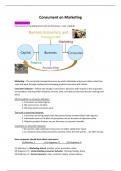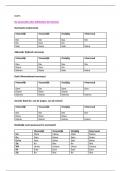Consument en Marketing
HOORCOLLEGE 1
Consument en marketing focust zich op Consumer > naar > Bedrijf
Marketing = The social and managerial process by which individuals and groups obtain what they
need and want through creating and exchanging products and value with others.
Consumer behavior = reflects the totality of consumers’ decisions with respect to the acquisition,
consumption, and disposition of goods, services, time, and ideas by (human) decision making [over
time].
Misconceptions in consumer behavior:
1. Consumers are Sales Figures.
2. We can trust our intuition.
3. We know what consumers want.
The truth in consumer behavior:
1. Consumers are living people (not data points/simply numbers/dead sales figures).
2. Individuals react on the basis of perception; not on the basis of objective reality.
3. Objective product features are not the same as consumer benefits.
Conclusion on consumer behavior:
> We need to really understand consumers to better satisfy their needs.
> our intuitions about what consumers perceive, think, feel and will do … are often wrong.
How companies should think about consumers:
(1) Stimulus, S > (2) Organism, O > (3) Response, R
(1) Stimulus, S = Marketing stimuli: product, price, promotion, place
(2) Organism, O = Understanding consumer behavior: thinking, feeling, doing
(3) Response, R = Succes measures: sales, customer loyalty, review valence
,Levels in consumer behavior
Level 1: Psychological core
Level 2: Process of making decisions
Level 3: Social influences
Pshychological Core
- Motivation, ability, and opportunity.
- Internal information: learning and memory.
- External Information: attention and perception.
- Understanding: comprehension and categorization.
- Attitudes: cognition and affect.
Process of making decisions
- Problem recognition an information search.
- Alternatives evaluation and decision making.
- Choice reflection and post-decision evaluations.
Social influences
- Conformity.
- Compliance.
- Obedience.
- Authority.
Understanding = a mental construct, an abstraction made by the human mind to make sense of
many different pieces of knowledge.
Causality = Dit verwijst naar het idee dat een verandering in één variabele direct de verandering in
een andere variabele veroorzaakt. Met andere woorden, er is een oorzaak-en-gevolgrelatie tussen de
twee variabelen. Als A de oorzaak is van B, betekent dit dat veranderingen in A direct leiden tot
veranderingen in B.
Correlation = Dit verwijst naar een statistische relatie tussen twee variabelen, waarbij veranderingen
in de ene variabele samengaan met veranderingen in de andere variabele. Echter, een correlatie
geeft geen oorzaak-en-gevolgrelatie aan. Het betekent simpelweg dat er een patroon is waar te
nemen tussen de variabelen, maar het kan zijn dat een derde factor de relatie veroorzaakt, of dat het
puur toeval is. Met andere woorden, correlatie betekent niet automatisch causaliteit.
The two criteria of causal reasearch:
1. Identifying which variables are the “cause” and which variables are the “effect”.
2. Understanding the nature of the relationship between the cause-and-effect variables.
Structure of a causal research:
1) Positioning of research problem
2) Research question
3) Literature review
4) Research method and data analysis
5) Results
6) Managerial recommendations
,Univariate data analysis: Frequencies and distribution, Graphic analysis, (Re)Coding
Multivariate data analysis: Regression analysis, Analysis of variance (ANOVA), Conjoint analysis,
Discriminant analysis, Multi dimensional scaling (MDS), Cluster analysis etc.
VOORBEELD: (correlatie VS causaliteit, bottle design)
Onderzoek of het aanbod van het product, de verpakking en het vulniveau van de verpakking invloed
hebben op de hoeveelheid product die de consument gebruikt.
- Het beschikbare aanbod beïnvloedt de hoeveelheid die wordt geconsumeerd een
eenmalige gebruiksmomenten.
- Een noodzakelijke en voldoende voorwaarde voor aanbod om het gebruik te beïnvloeden
blijkt te zijn dat de beschikbare hoeveelheid visueel meetbaar is.
- Het gebruik neemt af naarmate het aanbod afneemt, tot een bepaald punt.
SUMMERY
- To manage customers, we need to really understand (not just know) how/why/when/where they
process information and make decisions and look back on them.
- Decisions are often complex and difficult. To make decisions quickly and efficiently, consumer use
several heuristics (i.e., cognitive shortcuts).
- Heuristics can lead to systematic errors and biases; mistakes people repeat over-and-over again
(i.e., not always rational but sometimes predictably irrational)
- Understanding both rational and irrational behavior is important for consumers, managers and
policy makers in e.g. financial decision making, HR management, product pricing, marketing strategy,
health policies, et cetera.
, HOORCOLLEGE 2
Antecedents: (drives) of motivation
Successors: (consequences) of motivation
! Motivation, Ability and Opportunity affect consumer behavior. (MOA = Triade model)
> Bij de marathon finishen de meeste mensen rond de hele en halve uren. Dit is een motivatie van
de mensen, iedereen zet toch even iets harder bij/heeft een doel rond de hele en halve uren
> Tijdens corona ontbrak het aan opportunity. Dus speelde snapchat hierop in door een filter van de
schoenen te ontwerpen of Ikea van een filter om je huis opnieuw in te richten.
Ability Drivers:
- Product Knowledge and Experience
- Cognitive Style
- Intelligence, Education, and Age
- Money
Opportunities Drivers:
- Time
- Distraction
- Information
> Amount, Complexity, Repetition
! Chunken: De gelegenheid geven om informatie beter te onthouden (1_12_52_365…)
Motivation Drivers:
- Personal Relevance
- Consistency with the self, values, needs, goals, emotions
- Moderate inconsistency with attitudes
- Perceived Risk
> Highly motivated consumers are willing to spend more time on information search; i.e. it evokes a
psychological state called involvement
> Motivated consumers are more eager to learn about more alternatives
> When motivation to process brand information is low, attention is voluntarily allocated to stimuli
other than the brand or ad and
> Motivation to enhance attention is possible by appealing to intrinsic hedonic needs (e.g. appetite
appeals), using novel stimuli (e.g. unusual cinematography), or enhancing curiosity (e.g. metaphors)
> Consumers who give gifts from a sense of obligations are more likely to select utilitarian gifts as
compared to those why give gifts from a voluntary motive; they buy more hedonic gifts
> Consumers attribute higher levels of pro-environmental behavior and motivation, but lower levels
of ability, to themselves than to other societal actors.
> hetgeen dat je zegt is niet altijd hetzelfde als wat je denkt of doet
(de grootste Harley Davidson klant is de 34-jarige accountant)
> mensen weten niet altijd wat ze zeggen of waar ze voor instemmen
(Engelsen gingen massaal zoeken op ‘wat is de BrExit’, toen het een feit was geworden)
> motivaties veranderen over tijd
(hoe ouder je wordt hoe minder je vatbaar bent voor sociale invloeden)





